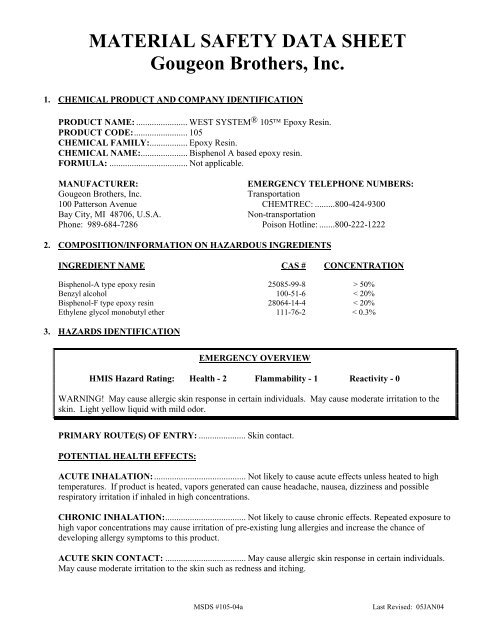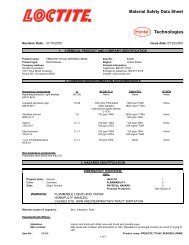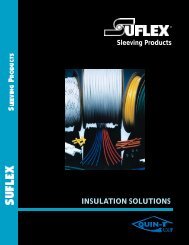West System Epoxy Resin 105 - Fiberglass Supply
West System Epoxy Resin 105 - Fiberglass Supply
West System Epoxy Resin 105 - Fiberglass Supply
You also want an ePaper? Increase the reach of your titles
YUMPU automatically turns print PDFs into web optimized ePapers that Google loves.
MATERIAL SAFETY DATA SHEET<br />
Gougeon Brothers, Inc.<br />
1. CHEMICAL PRODUCT AND COMPANY IDENTIFICATION<br />
PRODUCT NAME: ....................... WEST SYSTEM ® <strong>105</strong> <strong>Epoxy</strong> <strong>Resin</strong>.<br />
PRODUCT CODE:........................ <strong>105</strong><br />
CHEMICAL FAMILY:................. <strong>Epoxy</strong> <strong>Resin</strong>.<br />
CHEMICAL NAME:..................... Bisphenol A based epoxy resin.<br />
FORMULA: ................................... Not applicable.<br />
MANUFACTURER:<br />
EMERGENCY TELEPHONE NUMBERS:<br />
Gougeon Brothers, Inc.<br />
Transportation<br />
100 Patterson Avenue CHEMTREC: .........800-424-9300<br />
Bay City, MI 48706, U.S.A.<br />
Non-transportation<br />
Phone: 989-684-7286 Poison Hotline: .......800-222-1222<br />
2. COMPOSITION/INFORMATION ON HAZARDOUS INGREDIENTS<br />
INGREDIENT NAME CAS # CONCENTRATION<br />
Bisphenol-A type epoxy resin 25085-99-8 > 50%<br />
Benzyl alcohol 100-51-6 < 20%<br />
Bisphenol-F type epoxy resin 28064-14-4 < 20%<br />
Ethylene glycol monobutyl ether 111-76-2 < 0.3%<br />
3. HAZARDS IDENTIFICATION<br />
EMERGENCY OVERVIEW<br />
HMIS Hazard Rating: Health - 2 Flammability - 1 Reactivity - 0<br />
WARNING! May cause allergic skin response in certain individuals. May cause moderate irritation to the<br />
skin. Light yellow liquid with mild odor.<br />
PRIMARY ROUTE(S) OF ENTRY: ..................... Skin contact.<br />
POTENTIAL HEALTH EFFECTS:<br />
ACUTE INHALATION: ......................................... Not likely to cause acute effects unless heated to high<br />
temperatures. If product is heated, vapors generated can cause headache, nausea, dizziness and possible<br />
respiratory irritation if inhaled in high concentrations.<br />
CHRONIC INHALATION:.................................... Not likely to cause chronic effects. Repeated exposure to<br />
high vapor concentrations may cause irritation of pre-existing lung allergies and increase the chance of<br />
developing allergy symptoms to this product.<br />
ACUTE SKIN CONTACT: .................................... May cause allergic skin response in certain individuals.<br />
May cause moderate irritation to the skin such as redness and itching.<br />
MSDS #<strong>105</strong>-04a<br />
Last Revised: 05JAN04
Gougeon Brothers, Inc. Page 2 of 6 WEST SYSTEM ® <strong>105</strong> <strong>Resin</strong><br />
CHRONIC SKIN CONTACT: ............................... May cause sensitization in susceptible individuals. May<br />
cause moderate irritation to the skin.<br />
EYE CONTACT:..................................................... May cause irritation.<br />
INGESTION: ........................................................... Low acute oral toxicity.<br />
SYMPTOMS OF OVEREXPOSURE: .................. Possible sensitization and subsequent allergic reactions<br />
usually seen as redness and rashes. Repeated exposure is not likely to cause other adverse health effects.<br />
MEDICAL CONDITIONS AGGRAVATED BY EXPOSURE:<br />
Pre-existing skin and respiratory disorders may be aggravated by exposure to this product. Pre-existing lung<br />
and skin allergies may increase the chance of developing allergic symptoms to this product.<br />
4. FIRST AID MEASURES:<br />
FIRST AID FOR EYES........................................... Flush immediately with water for at least 15 minutes.<br />
Consult a physician.<br />
FIRST AID FOR SKIN ........................................... Remove contaminated clothing. Wipe excess from skin.<br />
Remove with waterless skin cleaner and then wash with soap and water. Consult a physician if effects occur.<br />
FIRST AID FOR INHALATION........................... Remove to fresh air if effects occur.<br />
FIRST AID FOR INGESTION .............................. No adverse health effects expected from amounts<br />
ingested under normal conditions of use. Seek medical attention if a significant amount is ingested.<br />
5. FIRE FIGHTING MEASURES:<br />
FLASH POINT: ....................................................... >200°F (Tag Closed Cup)<br />
EXTINGUISHING MEDIA: .................................. Foam, carbon dioxide (CO 2 ), dry chemical.<br />
SPECIAL FIRE FIGHTING PROCEDURES:<br />
Wear a self-contained breathing apparatus and complete full-body personal protective equipment. Closed<br />
containers may rupture (due to buildup of pressure) when exposed to extreme heat.<br />
6. ACCIDENTAL RELEASE MEASURES:<br />
SPILL OR LEAK PROCEDURES ........................ Soak up in absorbent material or scrape up. Residual<br />
can be removed with non-flammable solvent, but solvent should be used sparingly and with appropriate<br />
precautions.<br />
7. HANDLING AND STORAGE:<br />
STORAGE TEMPERATURE (min./max.):.......... 40°F (4°C) / 120°F (49°C)<br />
SHELF LIFE:........................................................... Three years or more in original sealed container.<br />
MSDS #<strong>105</strong>-04a<br />
Last Revised: 05JAN04
Gougeon Brothers, Inc. Page 3 of 6 WEST SYSTEM ® <strong>105</strong> <strong>Resin</strong><br />
STORAGE:............................................................... Store in cool, dry place. Store in tightly sealed<br />
containers to prevent moisture absorption and loss of volatiles. Excessive heat over long periods of time will<br />
degrade the resin.<br />
HANDLING PRECAUTIONS: .............................. Avoid prolonged or repeated skin contact. Wash<br />
thoroughly after handling. Launder contaminated clothing before reuse. Avoid inhalation of vapors from<br />
heated product. Precautionary steps should be taken when curing product in large quantities. When mixed<br />
with epoxy curing agents this product causes an exothermic, which in large masses, can produce enough heat<br />
to damage or ignite surrounding materials and emit fumes and vapors that vary widely in composition and<br />
toxicity.<br />
8. EXPOSURE CONTROLS/PERSONAL PROTECTION:<br />
EYE PROTECTION GUIDELINES: .................... Safety glasses with side shields or chemical splash<br />
goggles.<br />
SKIN PROTECTION GUIDELINES:................... Wear liquid-proof, chemical resistant gloves (nitrilebutyl<br />
rubber, neoprene, butyl rubber or natural rubber) and full body-covering clothing.<br />
RESPIRATORY/VENTILATION GUIDELINES:<br />
Good room ventilation is usually adequate for most operations. Wear a NIOSH/MSHA approved respirator<br />
with an organic vapor cartridge whenever exposure to vapor in concentrations above applicable limits is<br />
likely.<br />
ADDITIONAL PROTECTIVE MEASURES:...... Practice good caution and personal cleanliness to avoid<br />
skin and eye contact. Avoid skin contact when removing gloves and other protective equipment. Wash<br />
thoroughly after handling.<br />
OCCUPATIONAL EXPOSURE LIMITS: ........... Not established for product as whole. Refer to OSHA’s<br />
Permissible Exposure Level (PEL) or the ACGIH Guidelines for information on specific ingredients.<br />
9. PHYSICAL AND CHEMICAL PROPERTIES:<br />
PHYSICAL FORM: ................................................ Liquid.<br />
COLOR: ................................................................... Clear to pale yellow.<br />
ODOR: ...................................................................... Mild.<br />
BOILING POINT:................................................... > 400°F.<br />
MELTING POINT/FREEZE POINT:................... No data.<br />
VISCOSITY: ............................................................ 1,000 cPs.<br />
pH:............................................................................. No data.<br />
SOLUBILITY IN WATER:.................................... Slight.<br />
SPECIFIC GRAVITY:............................................ 1.15<br />
BULK DENSITY: .................................................... 9.6 pounds/gallon.<br />
VAPOR PRESSURE: .............................................. < 1 mmHg @ 20°C.<br />
VAPOR DENSITY: ................................................. Heavier than air.<br />
% VOLATILE BY WEIGHT: ............................... EPA Method 24, as described in 40 CFR Part 60, was<br />
used to determine the Volatile Matter Content of mixed epoxy resin and hardener. This method states that<br />
two-component coating systems should be tested by mixing the individual components together at the proper<br />
ratio. Refer to the hardener's MSDS for information about the total volatile content of the resin/hardener<br />
system.<br />
MSDS #<strong>105</strong>-04a<br />
Last Revised: 05JAN04
Gougeon Brothers, Inc. Page 4 of 6 WEST SYSTEM ® <strong>105</strong> <strong>Resin</strong><br />
10. REACTIVITY:<br />
STABILITY: ............................................................ Stable.<br />
HAZARDOUS POLYMERIZATION:.................. Will not occur by itself, but a mass of more than one<br />
pound of product plus an aliphatic amine will cause irreversible polymerization with significant heat buildup.<br />
INCOMPATIBILITIES:......................................... Strong acids, bases, amines and mercaptans can cause<br />
polymerization.<br />
DECOMPOSITION PRODUCTS: ........................ Carbon monoxide and carbon dioxide fumes may be<br />
produced when heated to decomposition.<br />
11. TOXICOLOGICAL INFORMATION:<br />
No specific oral, inhalation or dermal toxicology data is known for this product. Specific toxicology<br />
information for a bisphenol-A based epoxy resin present in this product is indicated below:<br />
Oral: ................................................. LD 50 >5000 mg/kg (rats)<br />
Inhalation: ........................................ No Data.<br />
Dermal: ............................................ LD 50 = 20,000 mg/kg (skin absorption in rabbits)<br />
TERATOLOGY:.............................. ………………Diglycidyl ether bisphenol-A (DGEBPA) did not cause<br />
birth defects or other adverse effects on the fetus when pregnant rabbits were exposed by skin contact, the<br />
most likely route of exposure, or when pregnant rats or rabbits were exposed orally.<br />
Ethylene glycol monobutyl ether (present at < 0.3 %) causes harm to the fetus in laboratory animal studies.<br />
Harm to the fetus occurs at exposure levels that harm the pregnant animal. The relevance of these findings to<br />
humans is uncertain.<br />
REPRODUCTIVE EFFECTS: ........ ……………….DGEBPA, in animal studies, has been shown not to<br />
interfere with reproduction.<br />
MUTAGENICITY:.......................... ………………..DGEBPA in animal mutagenicity studies were negative.<br />
In vitro mutagenicity tests were negative in some cases and positive in others.<br />
CARCINOGENICITY:<br />
NTP ..................................................................... Product not listed.<br />
IARC ................................................................... Product not listed.<br />
OSHA .................................................................. Product not listed.<br />
Many studies have been conducted to assess the potential carcinogenicity of diglycidyl ether of bisphenol-<br />
A. Although some weak evidence of carcinogenicity has been reported in animals, when all of the data<br />
are considered, the weight of evidence does not show that DGEBPA is carcinogenic. Indeed, the most<br />
recent review of the available data by the International Agency for Research on Cancer (IARC) has<br />
concluded that DGEBPA is not classified as a carcinogen.<br />
Epichlorohydrin, an impurity in this product (
Gougeon Brothers, Inc. Page 5 of 6 WEST SYSTEM ® <strong>105</strong> <strong>Resin</strong><br />
based on the following conclusions: human evidence – inadequate; animal evidence – sufficient. It has<br />
been classified as an anticipated human carcinogen by the National Toxicology Program (NTP).<br />
12. ECOLOGICAL INFORMATION:<br />
Prevent entry into sewers and natural waters. May cause localized fish kill.<br />
Movement and Partitioning:<br />
Bioconcentration potential is moderate (BCF between 100 and 3000 or Log Kow between 3 and<br />
5).<br />
Degradation and Transformation:<br />
Theoretical oxygen demand is calculated to be 2.35 p/p. 20-day biochemical oxygen demand is<br />
Gougeon Brothers, Inc. Page 6 of 6 WEST SYSTEM ® <strong>105</strong> <strong>Resin</strong><br />
COMPONENT NAME<br />
/CAS NUMBER CONCENTRATION STATE CODE<br />
Epichlorohydrin<br />
106-89-8 < 5ppm<br />
1 CA<br />
Phenyl glycidyl ether<br />
122-60-1




